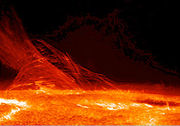Sun
Sun
Characteristics
The Sun's color is white, although from the surface of the Earth it may appear yellow because of atmospheric scattering of blue light. Its stellar classification, based on spectral class, is G2V, and is informally designated a yellow star, because its visible radiation is most intense in the yellow-green portion of the spectrum. In this spectral class label, G2 indicates its surface temperature of approximately 5778 K (5505 °C), and V indicates that the Sun, like most stars, is a main sequence star, and thus generates its energy by nuclear fusion of hydrogen nuclei into helium.
In its core, the Sun fuses 430–600 million tons of hydrogen each second. Once regarded by astronomers as a small and relatively insignificant star, the Sun is now thought to be brighter than about 85% of the stars in the Milky Way galaxy, most of which are red dwarfs.[14][15] The absolute magnitude of the Sun is +4.83; however, as the star closest to Earth, the Sun is the brightest object in the sky with an apparent magnitude of −26.74.
The Sun's hot corona continuously expands in space creating the solar wind, a stream of charged particles that extends to the heliopause at roughly 100 astronomical units. The bubble in the interstellar medium formed by the solar wind, the heliosphere, is the largest continuous structure in the Solar System.
